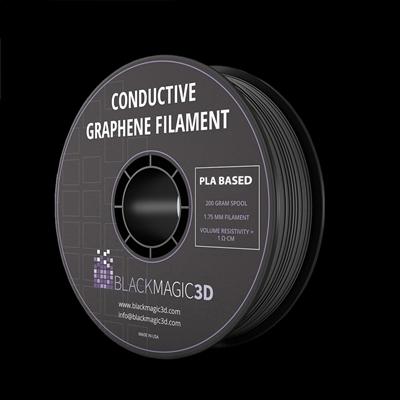June 18, 2015

Conductive 3D printing (3DP) material isn't a new idea. We've reported on conductive 3DP inks and filament several times, including Voxel8's conductive ink, Optomec's Aerosol Jet spray technology, and Chinese firm eSUN's conductive ABS filament.
Now there's a new kid on the block, Graphene 3D Lab. The company has added graphene to 3DP filament to strengthen the material and add conductivity to prints made with it. The material, Black Magic 3D, is a PLA incorporating proprietary nano-composite carbon materials based on graphene. It can be used to 3D print conductive traces embedded in 3D-printed parts for electronics, as well as capacitive touch sensors.

In her talk given at RAPID 2015 in Long Beach, Calif., Graphene 3D Lab's chief operating officer Elena Polyakova discussed how graphene-based materials can enable multimaterials 3DP in electronics, energy storage, and other commercial applications. Electronic devices, for instance, require several different materials, which can't be combined using current 3DP technology. But conductive filaments make it possible to combine both insulating and conductive parts in a 3D-printed object.
Graphene, which is a single layer of carbon atoms, is still considered an exotic material by many, but that seems to be changing. For instance, it's already being used in the development of high-density super-capacitors to replace rechargeable batteries, as Design News has reported. As Polyakova said, it has the characteristics of a wonder material. It's a better heat conductor than all other materials, equal to copper in its electrical conductivity, stronger than diamond, and almost completely transparent.
MORE FROM DESIGN NEWS: 12 New & Notable 3D Printing Products from RAPID 2015
Much of this commercial use has been made possible by the experiments done by the winners of the 2010 Nobel Prize in Physics. The prize was awarded to two University of Manchester, UK scientists for demonstrating the exceptional properties of the material and developing a method for extracting a stable one-atom-thick layer.
Polyakova said that when graphene platelets are added to a polymer matrix, they form a conductive network with high in-plane conductivity, a low percolation threshold of 0.1%, and chemical inertness. Conductive 3DP filaments based on graphene such as Black Magic may be used to produce 3D circuits, sensors, electromagnetic shielding, antennas, and electrodes.
MORE FROM DESIGN NEWS: Hybrid 3DP/CNC System for Metals Costs Less
If you want to try 3D printing your own circuit boards from the output of standard PCB layout software and have a dual-head filament printer plus some Black Magic filament, Rockfield Research's PCB2STL tool makes this possible. You can download it here.
Graphene 3D Lab is developing graphene-based nanocomposite materials for various types of 3D printing, including fused filament fabrication. The video below shows an example of Graphene 3D Labs' emerging technology: a battery with each of its parts 3D printed from materials formulated from the company's proprietary technologies.
The company is also involved in the design, manufacture, and marketing of 3D printers and related products. Earlier this year, it contracted with ZeGo Robotics to develop a proof-of-concept 3D printer designed to print with Black Magic filament and other functionally enhanced composites.
Last year Graphene 3D Lab was spun off from Graphene Laboratories, which offers analytical services, prototype development, and consulting for bringing a variety of graphene-based materials and devices to market. Graphene Laboratories also operates Graphene Supermarket, a major global manufacturer and supplier of nanocarbon and graphene materials to Tier 1 companies such as Apple Computer, Ford and Toyota, as well as NASA and the US Army.
Ann R. Thryft is senior technical editor, materials & assembly, for Design News. She's been writing about manufacturing- and electronics-related technologies for 27 years, covering manufacturing materials & processes, alternative energy, and robotics. In the past, she's also written about machine vision and all kinds of communications.
About the Author(s)
You May Also Like



